Minnesota’s expansive woodlands, shimmering lakes, and intricate ecosystems serve as a rich tapestry for bird enthusiasts. Nestled within its natural beauty are flashes of brilliant orange, a testament to the state’s avian diversity.
From the melodic calls of the Orioles to the striking appearance of the Tanagers, Minnesota proudly hosts a range of orange-feathered wonders. Dive in as we explore the 9 orange birds that grace this state with their vibrant presence.
Orange Birds Found In Minnesota
Minnesota, known for its vast lakes and forests, provides a habitat for a variety of bird species, including those with orange or orange-tinged plumage. This list includes both residents and migrants that can be seen during specific seasons.
Baltimore Oriole


| Feature | Measurement |
|---|---|
| Scientific Name | Icterus galbula |
| Length | 6.7–8.7 in |
| Wingspan | 9.1–12.6 in |
| Weight | 22.3-42 g |
The Baltimore Oriole is a stunning bird, best known for its vibrant coloration and its rich, whistling song.
Appearance: The male Baltimore Oriole is notable for his bright orange and black plumage and black and white wing bars, a stark contrast to the more muted yellow-brown coloration of the female. Both sexes, however, have long pointed bills and white bars on their wings.
Diet: Baltimore Orioles have a diverse diet that includes insects, fruits, and nectar. Their preference for sweet juices and fruit pulp often brings them to backyard feeders offering oranges and jelly.
Reproduction: The female Baltimore Oriole is responsible for building the distinctive hanging nest, often woven together from fine materials like hair and grass. These nests are usually high in trees to avoid predators. The female lays 3-7 eggs, which are incubated for about two weeks.
Orchard Oriole
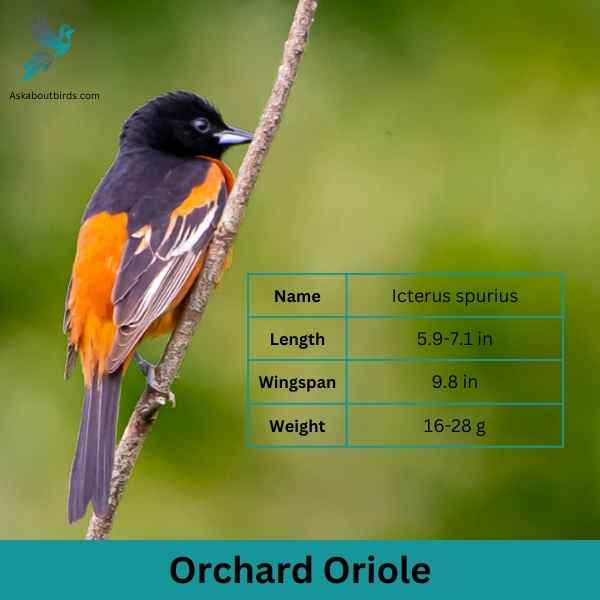
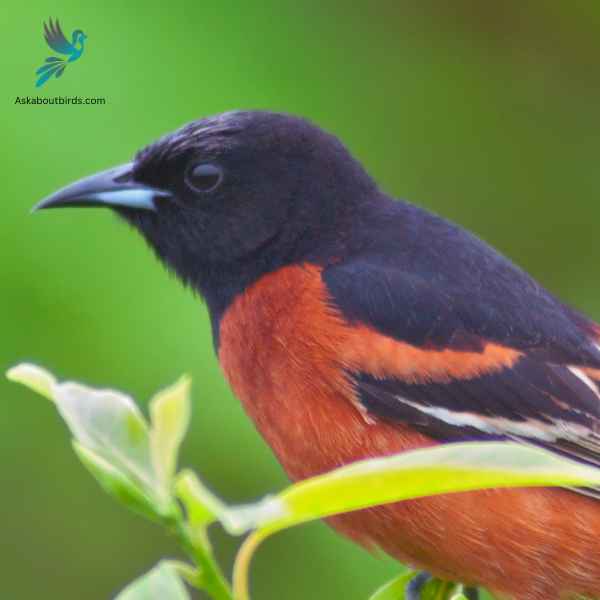
| Feature | Measurement |
|---|---|
| Scientific Name | Icterus spurius |
| Length | 5.9-7.1 in |
| Wingspan | 9.8 in |
| Weight | 16-28 g |
The Orchard Oriole is a small songbird noted for its distinctive coloration and melodic song.
Appearance: Male Orchard Orioles are a striking sight with their dark chestnut body and black head and black and white wings, while females and immature males are olive-green and feature a yellowish underpart. The species is often recognized by its slender body and pointed bill.
Diet: The diet of the Orchard Oriole consists primarily of insects, fruits, and nectar. They are adept at catching insects mid-air and are also known to sip nectar from flowers, aiding in pollination. When fruits are in season, they make up a substantial portion of the bird’s diet.
Reproduction: Orchard Orioles often nest in open woodlands and orchards, hence their name. The female is responsible for building the nest, typically choosing a location in a tree or shrub. The female lays a clutch of 4 to 6 eggs, which she incubates for about two weeks.
Scarlet Tanager


| Feature | Measurement |
|---|---|
| Scientific Name | Piranga olivacea |
| Length | 6.3 to 7.5 in |
| Wingspan | 9.8 to 11.8 in |
| Weight | 23.5 to 38 g |
The Scarlet Tanager is a strikingly colorful bird known for its brilliant plumage and distinctive song.
Appearance: Male Scarlet Tanagers are notable for their vibrant scarlet bodies contrasted with black wings and tail, making them one of the most intensely colored birds. Females and juveniles, on the other hand, have a subdued olive-yellow body color with darker wings and tail.
Diet: The diet of the Scarlet Tanager is largely made up of insects, including beetles, cicadas, aphids, and others. They are adept flycatchers, seizing insects in mid-air or picking them off foliage. They also consume fruits and berries, especially during migration and in their winter habitats.
Reproduction: The female Scarlet Tanager builds a cup-shaped nest using twigs, rootlets, and grass, typically well-hidden in the dense foliage of trees. She lays 3 to 5 eggs and incubates them for about two weeks.
American Redstart


| Feature | Measurement |
|---|---|
| Scientific Name | Setophaga ruticilla |
| Length | 4.3 to 5.5 in |
| Wingspan | 6.3 to 9.1 in |
| Weight | 8.6 g |
The American Redstart is a lively warbler known for its vivid colors and active hunting style, often seen flitting about, fanning its tail to startle and catch insects.
Appearance: Adult male American Redstarts boast striking black plumage with bright orange patches on the sides, wings, and tail. Females and immature males have grayish-olive upperparts with yellow patches in the same areas where the males display orange.
Diet: American Redstarts are primarily insectivores. They actively forage for flying insects, as well as caterpillars and spiders, often using their colorful tails to startle prey and make them easier to catch.
Reproduction: The female American Redstart builds a cup-shaped nest in the fork of a tree branch. Typically, she lays a clutch of 3 to 5 eggs. The female takes on the primary responsibility of incubating the eggs, while both parents participate in feeding the fledglings after they hatch.
Eastern Towhee

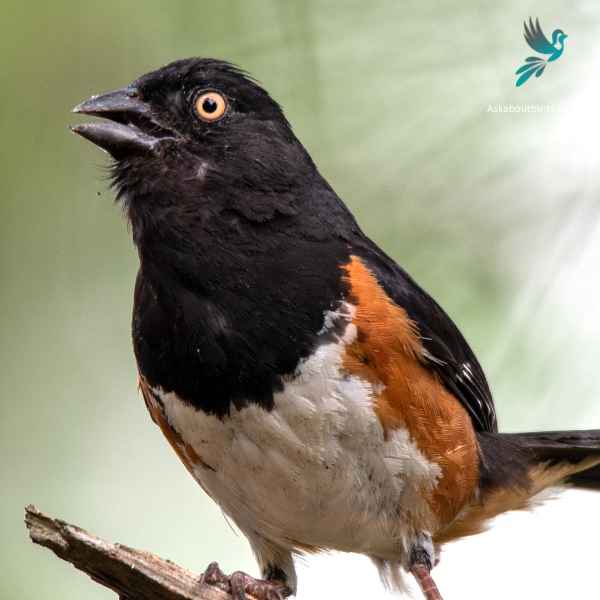
| Feature | Measurement |
|---|---|
| Scientific Name | Pipilo erythrophthalmus |
| Length | 6.8 to 9.1 in |
| Wingspan | 7.9–11.8 in |
| Weight | 32 to 53 g |
The Eastern Towhee is a distinctive songbird known for its unique calls and eye-catching coloration.
Appearance: Male Eastern Towhees are characterized by a striking combination of a black head, back and tail, contrasting with a white belly and rufous flanks. Females sport similar patterns but instead of black, they have a rich brown color. Both genders have red eyes, lending a special charm to their overall appearance.
Diet: Eastern Towhees primarily feed on a variety of insects, seeds, and berries. Their diet is quite diverse, taking advantage of seasonal offerings, which includes beetles, caterpillars, spiders, acorns, grass seeds, and various fruits and berries.
Reproduction: Eastern Towhees build their nests on or near the ground, often in a shrub or a small tree. The female lays around 3-5 eggs and takes the primary role in incubating them over about 12-13 days.
Northern Flicker

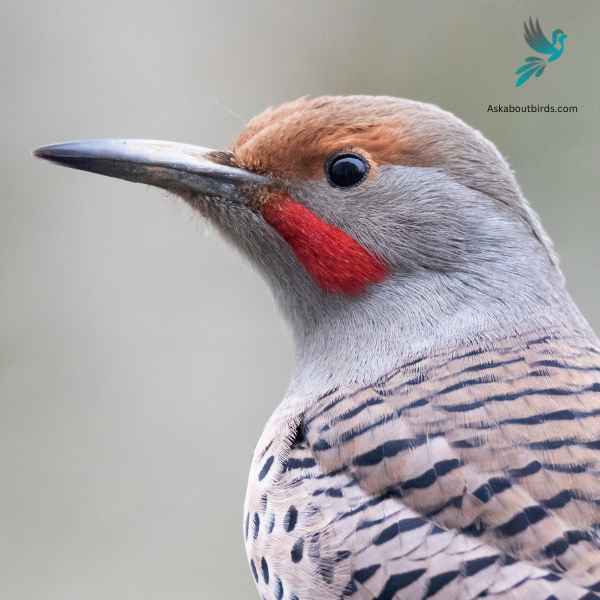
| Feature | Measurement |
|---|---|
| Scientific Name | Colaptes auratus |
| Length | 11–12 in |
| Wingspan | 17–20 in |
| Weight | 3.9–5.6 oz |
The Northern Flicker is a medium-sized woodpecker, recognized by its unique patterns and coloring, often found drumming on trees or foraging on the ground across North America.
Appearance: The Northern Flicker stands out with its grayish brown body, black-scalloped plumage, and a black bib. Males sport a distinctive black or red mustache stripe. Depending on the subspecies, the underwing and undertail feathers can be bright yellow or red, flashing vividly during flight.
Diet: While most woodpeckers are tree-bark foragers, the Northern Flicker prefers hunting on the ground. Its primary diet consists of ants and beetles, supplemented occasionally by fruits, berries, seeds, and other small insects.
Reproduction: Northern Flickers are cavity nesters, preferring to excavate their nesting hole in dead or diseased tree trunks. The interior of the nest is lined with wood chips.
Barn Swallow

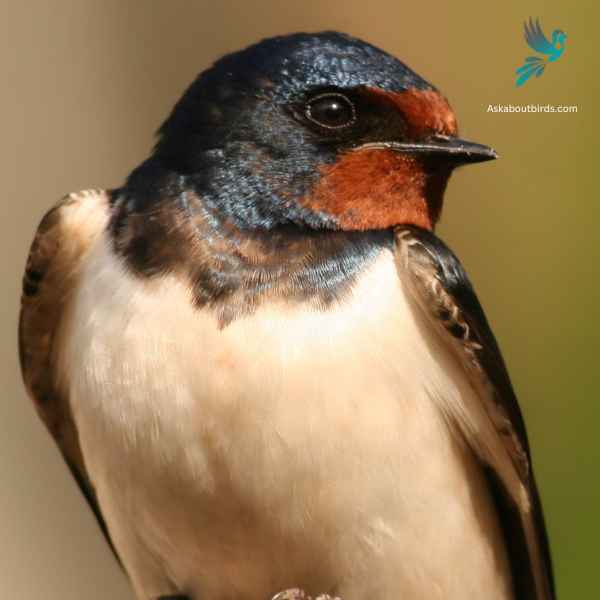
| Feature | Measurement |
|---|---|
| Scientific Name | Hirundo rustica |
| Length | 6.5–7.5 in |
| Wingspan | 12.5–13.5 in |
| Weight | 16–22 g |
The Barn Swallow is a sleek, agile bird renowned for its graceful flight patterns and iconic forked tail, often seen darting over fields and water bodies in search of flying insects.
Appearance: Barn Swallows have deep blue, almost iridescent, upperparts and a rufous to tawny underbelly. Their distinctively forked tail and long wings give them a streamlined look. Both males and females have a similar appearance, though males often exhibit slightly brighter colors and a deeper fork in the tail.
Diet: Barn Swallows feed primarily on flying insects, which they catch in mid-air during their agile and acrobatic flights. Their diet includes flies, beetles, moths, and other small flying insects.
Reproduction: Barn Swallows are known for building their mud nests on man-made structures, particularly barns, bridges, and eaves. The nest is cup-shaped and made from mud pellets, often lined with feathers. The female lays a clutch of 4 to 6 eggs.
American Robins


| Feature | Measurement |
|---|---|
| Scientific Name | Leptotila plumbeicep |
| Length | 10.6-11.8 in |
| Wingspan | — |
| Weight | 160-200 g |
The American Robin is a widely recognized bird species known for its melodious song and early bird tendencies.
Appearance: American Robins are medium-sized birds with a distinctive appearance. Both males and females sport a gray to brown back and a warm red to orange breast and belly and gray wings. They also have a characteristic white eye-ring and a black head, but males are usually darker than females.
Diet: American Robins have a diverse diet that changes depending on the season. In summer, they feed heavily on earthworms, beetles, and other invertebrates, which they catch on the ground. During winter, they mostly eat fruits and berries.
Reproduction: American Robins usually build their nests in trees or shrubs, but they are also known to nest on human-made structures. The female lays a clutch of about 3 to 5 eggs, which she incubates for about 12 to 14 days.
Summer Tanager


| Feature | Measurement |
|---|---|
| Scientific Name | Piranga rubra |
| Length | 6.7 in |
| Wingspan | 28 to 30 cm |
| Weight | 29 g |
The Summer Tanager is a medium-sized songbird admired for its radiant plumage and melodious song.
Appearance: Male Summer Tanagers are an impressive bright red, while females and juveniles present a softer, yellow-orange color. Both genders have a large, slightly hooked bill and relatively short tail.
Diet: Summer Tanagers primarily feed on insects, including bees and wasps, which they catch in flight or pick off vegetation. They are also known to eat fruits and berries, making them helpful in controlling pest populations and seed dispersal.
Reproduction: The female Summer Tanager builds a loose, shallow cup-shaped nest out of twigs and grass, usually hidden in the foliage of trees. The female typically lays 3-5 eggs, which she will incubate for about two weeks.
Where to Spot Minnesota’s Orange Birds
Minnesota, with its shimmering lakes and expansive forests, is a haven for bird enthusiasts. As a connoisseur of orange avians, I’ve traversed this captivating state to pinpoint the prime locales for observing these radiant birds. Below are the top spots I recommend:
- Agassiz National Wildlife Refuge: Nestled in the heart of the Red River Valley, this refuge boasts more than 200 bird species. The diverse wetland habitats make it an ideal spot for both migratory and resident birds.
- Tamarac National Wildlife Refuge: The meld of hardwood forests, wetlands, and lakes attracts an array of bird species, including many of our favorite orange-hued wonders. Its location is especially advantageous during the migratory seasons.
- Sax-Zim Bog: A treasured location for birders, this vast bog offers a unique ecosystem that attracts rare species. In the colder months, it’s a spectacle of winter birds, but spring and summer bring the vibrant colors of warblers and tanagers.
- Minnesota Valley National Wildlife Refuge: Situated near the Twin Cities, this refuge is not just convenient but also teeming with birdlife. Its varied habitats, from wetlands to forests, host a diverse range of species year-round.
- Itasca State Park: Known as the headwaters of the Mississippi River, Itasca’s old-growth pine forests and over 100 lakes create an idyllic backdrop for birdwatching, with many orange birds making a prominent appearance in the warmer months.
| Neighboring State | Best Spots for Orange Birds |
|---|---|
| North Dakota’s Orange Birds | 1. Lostwood National Wildlife Refuge 2. Chase Lake 3. Audubon National Wildlife Refuge |
| South Dakota’s Orange Birds | 1. Badlands National Park 2. Custer State Park 3. LaCreek National Wildlife Refuge |
| Wisconsin’s Orange Birds | 1. Horicon Marsh 2. Chequamegon-Nicolet National Forest 3. Crex Meadows |
| Iowa’s Orange Birds | 1. Neal Smith Wildlife Refuge 2. Yellow River State Forest 3. Big Marsh Wildlife Area |
FAQs on Orange Bird Species Found in Minnesota
What kind of bird has an orange throat in Minnesota?
In Minnesota, the Blackburnian Warbler is recognized for its striking orange throat, especially evident in adult males. These songbirds can be spotted in mature coniferous forests throughout the state during the breeding season. Their brilliant orange throat, contrasted by their black and white plumage, makes them a standout among Minnesota’s avian population.
What Minnesota bird has a bright orange beak?
The American White Pelican, often found in Minnesota’s lakes during the warmer months, boasts a bright orange beak. This large waterbird utilizes its colorful bill, which can span over a foot in length, for scooping up fish. The contrast between its white body and the bright beak is a captivating sight for birdwatchers.
What bird is orange with a black head in Minnesota?
The Baltimore Oriole, with its vibrant orange body and contrasting black head, is a summer favorite in Minnesota. They are often found building pendulous nests on tree branches and are attracted to backyard feeders offering sweet treats. Their striking coloration and melodic song bring joy to those lucky enough to spot them.
What orange and yellow birds can Minnesotans commonly find at bird feeders?
Bird feeders in Minnesota frequently attract colorful birds, thanks to the state’s rich bird diversity. The Northern Cardinal, a bird with a bright orange plumage and a distinctive black mask, is a common sight, especially in Southern Minnesota. Other birds include the Western Meadowlark, known for its bright yellow belly. To attract orioles put out grape jelly or orange slices. pale brown brown wings northern minnesota
Which birds with bright yellow feathers are native to Minnesota?
Minnesota boasts a variety of birds with bright yellow markings. The Yellow-rumped Warbler, distinguishable by its yellow heads, bright yellow throat, and matching rump, can be found in open woods and forest edges. Another beautiful bird to spot is the Rose-breasted Grosbeak, identifiable by its black and white wings with streaks of bright yellow on its belly. These birds primarily visit bird feeders stocked with black oil sunflower seeds.
What bird has pale brown plumage and brown wings in Northern Minnesota?
In Northern Minnesota, the Veery, a type of thrush, is recognized by its pale brown plumage and slightly darker brown wings. This understated bird is often found in dense, moist woodlands, singing its ethereal, descending song. The Veery’s subtle coloration allows it to blend seamlessly with the forest floor, making it a treat for birdwatchers who can spot this elusive species.




